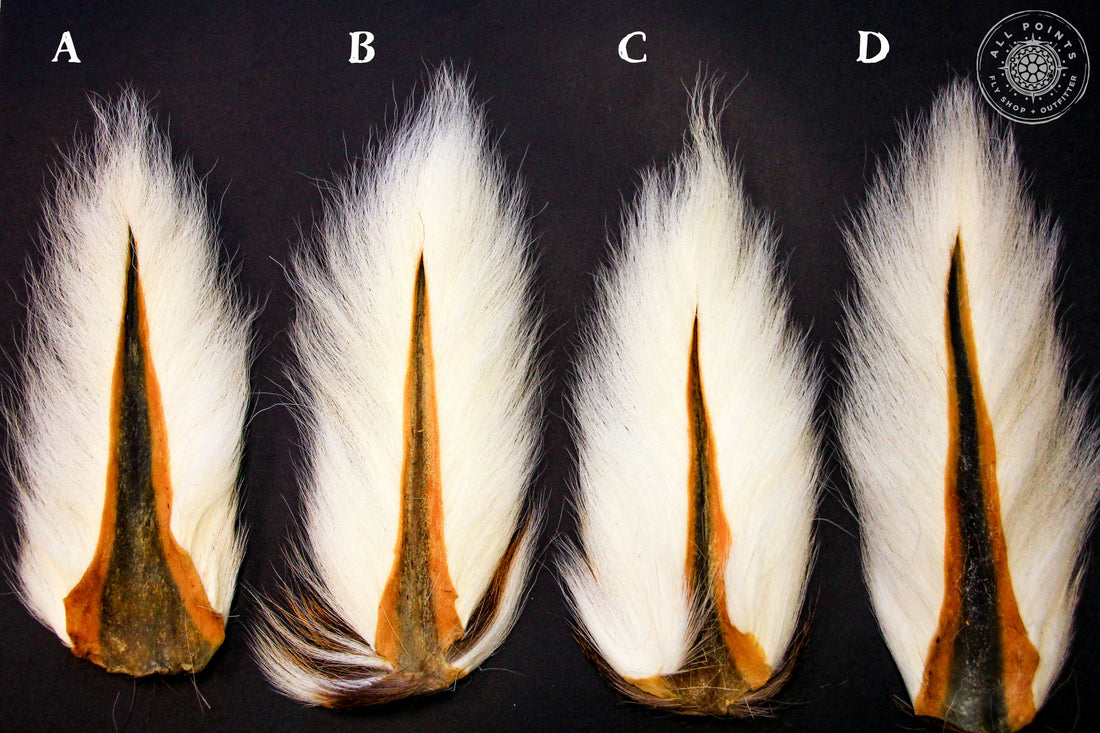
What To Look For When Choosing Bucktail For Fly Tying
Share
Here you are - sitting and staring at a rack of bucktails. You want to go home, tie some new patterns for your next fly fishing trip, but you want to get the best possible product for this next top producing fly you're about to spin up...so, what do you look for? At a quick glance bucktails seemingly all look the same. Some are shorter, some longer, some wider, etc., but for the most part bucktail hair is all the same, right? Well not exactly. In the same way that human hair varies widely from person to person, so does bucktail. Plus, depending on who treated or how it was treated, the hair can change even further. It's important to remember that there is no one perfect bucktail for every fly/use.
Hair Features + Traits
If you look at Bucktail A (far left), the hairs are more "wavy" and zig-zaggy than the others. This characteristic can help achieve different shapes, sizes, + techniques which a bucktail with straighter hairs would have a hard time doing. This inherent wavy-ness translates primarily into volume as it takes up more space than straight fibers. A lot of tyers who are going for fatter/fuller/larger profile baitfish patterns utilize wavier hair in some way. Look at how wavy the hairs are in the picture below...

On the other hand, the fine + straight hairs are what tyers are looking for when movement, (more slender) shape, length, and control of taper are of the highest concerns. You will find that most common bucktail deceivers are tied using a majority of straight fibers. Notice how much straighter the fibers are in the picture below...

Combining The Two -- It doesn't take much thought to then figure that a combination of the two different types of hairs would provide a great assortment of material for a wider range of styles, patterns, and techniques! For instance - a common technique is to use the straighter hairs for the first few ties to create the initial length and tail sections - and then towards the middle/head use wavier hairs to produce perceived volume and head shape. This is a great style of tying used a lot for saltwater baitfish imitations here in New England.
Same Tail - Different Hairs...
You will notice that the hairs of a bucktail change depending on where it is on the tail. The softer/finer hairs are found towards the end/tip of the tail and usually are along and down towards the middle as well. However, the hairs at the bottom of the tail are more coarse, wider, and "flare" when tied onto the hook. It is also the most buoyant hair. So even within the same tail, you will find an assortment of hairs which will behave and look different when tied onto a hook. In the same way that the "wavy" hairs will be good for collars/heads - the more coarse hairs at the bottom work well for this as well!
Length
If you haven't taken the tails out of the package yet to inspect during your shopping, this is the time to do it. Most freshwater trout flies/streamers can be tied with almost any bucktail (size) as it provides enough length (unless we're talking larger patterns, etc). But, for the saltwater angler who is looking to tie larger baitfish imitations, length can be extremely important. If you find a bucktail that has fibers in the 5-7in range - that is generally considered to be a keeper...Anything longer and you immediately buy it, haha! Although, a way to achieve length if you cannot with the given bucktail can be done with synthetics such as EP Fibers (especially if used as one of the first ties which usually determine the fly's length).
Hope that helps! Bucktail is an amazing natural material which really has no rival in the artificial world. Man made synthetics simply have not been able to replicate the movement and taper of the bucktail fibers. There is no substitute in my opinion.
Words + Photos: Josh Thelin


